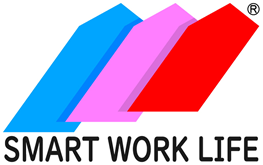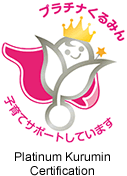- Home
- Sustainability
- Social
- Human Resources Management
- Initiatives for Everyone to Work in Their Own Ways
Sustainability
Social
Human Resources Management Initiatives for Everyone to Work in Their Own Ways
The OKI Group is working to improve the flexibility of work places and hours and to support employees in balancing work with childcare and caregiving so that everyone can work productively in their own ways and maximize their abilities.
Initiatives for Everyone to Work in Their Own Ways
We launched the Smart Work-Life Project in fiscal year2020 and implemented the following various initiatives by fiscal year2022 based on the concept of "overwhelming improvement of work-life quality by maximizing time value."
About the smart work-life logo

The three arrows represent society, life, and the Company, and the logo expresses our aim of achieving a work-life balance and work styles that enable these three elements to mutually support each other as they grow.
Blue: "society," represented by the color of a clear blue sky
Pink: "life," a color that represents the uniqueness of each employee
Red: "the Company," the OKI Group's color
Major Initiatives
| Purpose | Main measures |
|---|---|
| Greater flexibility in working location and hours | Introducing various systems (telework, super-flex-time work, work outside commuting area) |
| Promoting the digitalization of invoices and contracts | |
| Office reorganization and rearrangement | Reducing office space in the Tokyo area |
| Renovating Toranomon and Shibaura offices | |
| Expanding in-house satellite offices and external shared offices | |
| Developing network environments (both in-house and home environments) | |
| Reducing and digitalizing documents in storage | |
| Monitoring to improve work engagement | Pulse Survey |
| Monitoring of awareness of improved job satisfaction |
Greater Flexibility in Work Location and Hours
Since fiscal year 2020, OKI has expanded its telework system and provided benefits, and around half of OKI's employees, excluding those in plant divisions, are currently teleworking at least three days per week. In April 2021, OKI introduced the "Work Outside Commuting Area System," which permits employees who live outside the commuting area to telework, with the aim of reducing the number of employees who must transfer (move) because they are assigned to an area outside their commuting area or must move without their families (live separately from their families), as well as reducing the number of employees who leave OKI due to their spouse transferring or the burden of childcare and caregiving. Since fiscal year 2022, OKI has also implemented a new super-flex time system that eliminates both core time and minimum working hours per day, thereby enabling employees to adjust and decide independently and autonomously on their working hours.
In fiscal year 2023, we made a guidebook for side jobs to further support diverse work styles.
In addition, as a system to support improved work-style flexibility, in fiscal year 2021, we introduced the "Smart Work-Life Award System," which enables employees to vote on and recognize examples of unique work-style efforts by individuals registered on our intranet. This is positioned as part of our activities aimed at improving Company-wide productivity. In addition, online seminars has been provided for managers and general employees—on themes such as our principles of management, MBO, and the revitalization of communication—and, by fiscal year 2022, 90% of all OKI Group managers and 40% of the group's general employees participated in these seminars. In this way, we are striving to improve the organizational performance and support the management of the Group as a whole.
Office Reorganization and Rearrangement
In fiscal year 2021, OKI newly defined its Toranomon office as a "space for co-creation with customers" and a "space for employee collaboration," introducing open seating at workspaces and establishing café-style meeting spaces. We have increased co-creation opportunities by turning our rooms into showrooms, including conducting demonstration testing of our remote communication system, and guiding customers through these showrooms along with our existing product and solution showrooms.
Given that the percentage of people coming to work is decreasing due to telework, we have reduced and renovated our aging Shibaura offices, and we took steps to respond to new work styles, including implementing free-desking, expanding meeting spaces, and setting up online meeting rooms (building new web booths, dividing meeting rooms, and reducing the scale of such rooms). In addition, we are expanding our in-house satellite offices and external shared offices as a way to increase business efficiency by reducing business travel time and to address the needs of employees who have difficulty working at home.
In response to the rapid increase in telework use, we are also striving to stabilize our online environment by increasing line speed and implementing various other measures to improve the connection quality of not only our in-house network but also the VPN environment used for working from home.
Shibaura Office

In our spacious free working space (photo on the right), we have set up table sets, a coffee server, a snack selling area, exercise bikes, etc. This space can be used for various purposes, including meetings, lunch, and relaxing.
Toranomon Office

Monitoring to Improve Work Engagement(*1)
Increasing work engagement requires an understanding of managerial issues and the provision of appropriate support. Therefore, we have been conducting an employee pulse survey since fiscal year 2020. Since fiscal year 2021, we have expanded the survey to approximately 12,000 employees of the OKI Group, and we have conducted monitoring three times a year and analyzed its results. We found that improvements in the work environment led to greater work efficiency. The importance of communication with others and linkage with organizational targets was also confirmed. In addition, we continue to conduct an annual awareness survey of all domestic Group employees to see whether the measures described above are contributing to a positive workplace and rewarding work for each employee.
- *1 We have been continuing this as a part of our initiatives to reform our organizational culture since fiscal year 2023.
Work Style Vision Book
In May of 2021, we created and started disseminating our "Work Style Vision Book" (which was revised and republished in July of 2022) as a way to get each employee to think about workplace work styles, increased business efficiency, and improved productivity, thereby enabling them to achieve dramatic improvements in work-life quality. In addition, in the second half of fiscal year 2022, we started using our intranet website to introduce work-style reforms and initiatives of each factory that could not be completely covered by our vision book as well as to distribute articles containing honest dialogues of both young and veteran employees on smart-work-life issues and ideas for making improvements, and we will continue to support this website.
Support for Balancing Work and Private Life
OKI has established various systems to support a balance between work and private life, while labor union and management members confirm working hours and leave utilization.
Support for Balancing Work and Childcare
To build a structure that enables employees to simultaneously handle both their job and childcare responsibilities, we provide "Training on Balancing Work and Childcare" for OKI Group employees as well as "Returning Employee Meetings"—which are attended by three parties: employees who have returned from childcare leave, their superiors, and the Human Resources and General Affairs Division—for anyone who is interested.
In order to encourage male employees to take leave for childcare purposes and leave of absence for childcare (hereinafter referred to as "childcare leave by men"), OKI introduced the "Baby8 Leave" system in October 2022, which allows employees to take up to 25 days (working days) of paid leave to care for a child within eight weeks after birth. The goal is to enable all employees who wish to take the leave to do so, and to increase the percentage of eligible employees taking the leave to 50% or more each year. Through the development of this system, we aim to foster an organizational culture that enables employees to balance work and childcare, regardless of their gender.

Character to Promote Childcare Leave by Men Baby8-chan
Designed by an employee of our special subsidiary OKI WorkWel
Childcare Leave Utilization Rate
- FY2022 OKI Group (domestic) childcare leave utilization rate for male employees: 84.9%
Changes in OKI's childcare leave utilization rate
| FY2020 | FY2021 | FY2022 | |
|---|---|---|---|
| Male | 50.6% | 52.9% | 81.7% |
| Female | 100.0% | 116.7% | 87.5% |
- * Calculated in accordance with the Act on Advancement of Measures to Support Raising Next Generation Children
Support to Handle Both Work and Caregiving
In fiscal year 2021, we started holding online seminars enabling employees to learn about corporate support systems, public long-term care insurance systems, etc. to provide information useful for simultaneously handling both work and caregiving.
Seminar theme and number of participants
| Theme | Number of participants | |
|---|---|---|
| FY2021 | Basics | 240 |
| FY2022 | Basics | 450 |
| Caring for persons with dementia | 429 |
Support System that Can Be Used to Balance Work with Childcare, Caregiving, etc.
| OKI | Legal Requirement | |
|---|---|---|
| Special Leave for Particular Purposes | Saved leave (paid) for which up to 50 days can be taken each year for reasons such as the care of sick/injured family members or the caregiving of family members, the vaccination of children, health examinations for infants, health examinations for children, and children's school events, childcare (within 56 days of birth), fertility treatment, volunteer activities. | - |
| Sick/Injured Childcare Leave | 5 days per child. Furthermore, up to 50 days can be taken each year using the Special Leave for Particular Purposes system, which is paid. | Can be taken for 5 days each year (10 days in the case of 2 or more children). |
| Caregiving Leave | 5 days for each applicable individual. Furthermore, up to 50 days can be taken each year using the Special Leave for Particular Purposes system, which is paid. | Can be taken for 5 days each year (10 days in the case of 2 or more applicable individuals). |
| Yearly Paid Leave | Units of usage: 1-day units, half-day units, and hourly units. | Units of usage: 1-day units. |
| Pre-Natal Working System | A working system with shortened hours that can be used, following the start of pregnancy, from the date pre-natal work conditions are requested until pre-natal leave is taken, or until childbirth. | - |
| Pre-Natal Leave | 56 days can be taken before delivery, including the date of childbirth. | 42 days can be taken before delivery, including the date of childbirth. |
| Childbirth Leave | Paid leave that can be taken for 5 days within 56 days of childbirth. | - |
| Childcare Leave | Can be taken until the child reaches 2 years of age. | In principle, can be taken until the child reaches 1 year of age. |
| Caregiving Leave | A total of 365 days can be taken for each applicable family member. | A total of 93 days can be taken for each applicable family member. |
| Shortened Working Hours (Childcare Work Conditions) | Can be used until the child completes the sixth year of elementary school. | Can be used until the child reaches 3 years of age. |
| Shortened Working Hours (Caregiving Work Conditions) | Can be used an unlimited number of times until the reason for the caregiving of the applicable family member has been resolved. | At least twice in the three-year period from the start of usage. |
| Overtime Limitation and Late-Night Work Exemption | Applied in the case of a request during the period from pregnancy until the child reaches completion of the sixth year of elementary school. | Applied in the case of a request during the period from pregnancy until the child reaches the beginning period of elementary school enrollment. |
| Flextime system | A system that enables employees to independently choose which hours they work during their workdays, subject to achieving contracted total monthly hours. We also offer a "superflex" system, with no "core time" requirements. | - |
| Telework system | Systems enabling working from home | - |
| System of Working Outside the Commuting Area | System enabling employees who live outside the commuting area to telework. | - |
Kurumin Certification

As a result of its support activities for balancing childcare and work, OKI received Platinum Kurumin certification as an excellent supporting company for child-raising. Based on the Act on Advancement of Measures to Support Raising Next Generation Children, the certification is awarded to Kurumin certified companies (OKI has granted Kurumin certification since 2017) that have executed such measures at a higher standard than before. OKI Software, based in Warabi City, Saitama Prefecture, has also received Kurumin certification since 2014.
Reports on misuse of public research funds and misconduct related to research
activities can also be filed from the page that opens when you click the above button.

